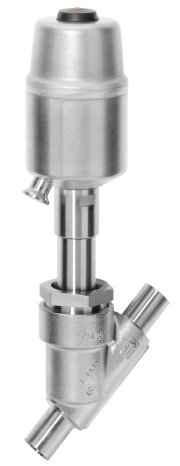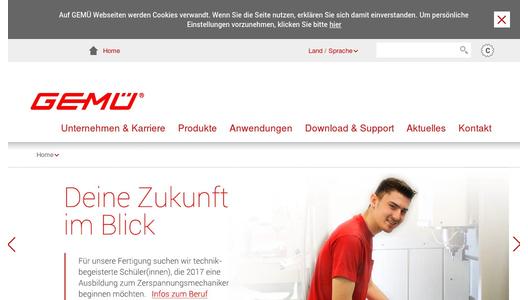In the foodstuff industry in particular, but also in the chemical and pharmaceutical industries, products must sometimes be manufactured aseptically. As a result, stringent requirements are placed on the purity of the working media used during manufacturing and even the steam used. If steam comes into contact with surfaces or directly with liquid or gaseous products during aseptic production, this contact must satisfy the purity requirements of the products. The solution is found in complex pure steam systems at product requirement level. The valve solutions used here must therefore satisfy very strict demands. GEMÜ is able to meet these requirements with the aseptic GEMÜ 505 and GEMÜ 555 globe valves.
Aseptic globe valve impresses in terms of both function and maintenance
The pneumatic (GEMÜ 555) and hand-operated (GEMÜ 505) angle seat globe valves have been specially developed for isolating pure steam in close collaboration with well-known customers from the pharmaceutical industry and provide a genuine alternative to the valve types which are usually used. They require significantly less maintenance than diaphragm valves, for example, and are easier to clean than ball valves. The globe valves are available in nominal sizes DN8 to DN80. Thanks to the metal bellows and selected seal materials, the temperature of the medium can range from -10 to +180 ºC. The butt weld spigot connections are designed and available in accordance with common standards such as ASME BPE, DIN 11866 or DIN EN ISO 1127.
High quality – reasonable price
All media-wetted parts are manufactured from high-quality stainless steel (316L) in order to meet the stringent requirements placed on the quality of the components used in the systems. The valve body is mechanically polished with high precision on the inside and electropolished on the outside. With this surface finish, GEMÜ is able, thanks to the body geometry on the inside of the body as well as extensive technical expertise, not only to produce Ra values of down to 0.4 µm but to even reliably reproduce them. Particular importance was also given to the seal materials, which also satisfy the stringent requirements of the FDA. The seals were tested according to USP Class VI at 121°C.
Even in the actuators, the materials and the processing of the individual materials are impressive, as is the case with the stainless steel bellows which accomplishes up to 100,000 cycle duties without problems and enables the actuator to use non-ferrous metals, for example. The sealing at the valve seat is provided by a seal made of extremely inert, acid-resistant and heat-resistant thermoplastic synthetic material (PTFE). The valve plug itself is welded to the valve spindle and is also smoothed in order to eliminate the otherwise usual "dirt pockets" which occur with valve plug solutions which are bolted together. The welded valve plug also ensures that this is connected permanently to the valve spindle, thereby increasing plant reliability. Because of these and other finer points, both angle seat globe valve variants provide a long service life including outstanding material properties and body geometries.
Traceability guaranteed
The stringent requirements placed on products in the pharmaceutical and foodstuff industries call for, amongst others, the traceability of all media-wetted parts in order to guarantee product quality and product reliability. For this reason, valve bodies, the retaining nut, seat, valve plug, spindle, bellows and actuator seal of the GEMÜ 555 and GEMÜ 505 are manufactured in specific batches and combined together in one production run. As a result, material test certificates in accordance with 3.1 DIN EN 10204, amongst others, can be issued and supplied with the product where necessary. In addition to the design of the valve as a low maintenance fitting in terms of material, it was also ensured that an actuator change can be carried out quickly, directly on the piping. This means it is possible to perform cost-effective maintenance and repair work and protects materials over the long term. If desired by the customer, the valve solution can also be subsequently automated, for example by switching from manual to pneumatic operation or by attaching electrical position indicators or positioners for open/close control.



